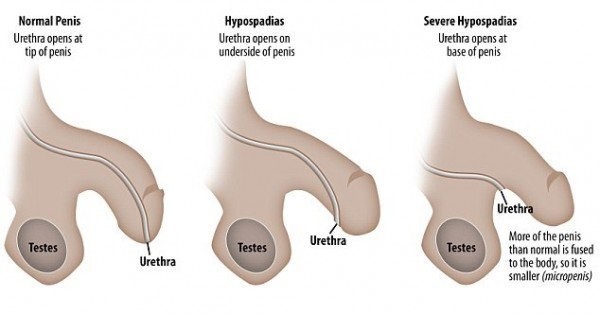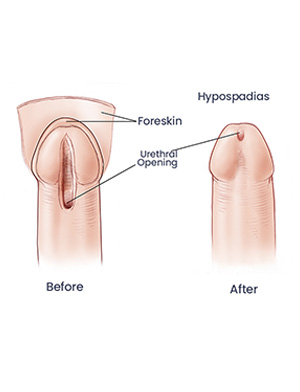It is a surgery offered for correction of abnormally located urinary opening on the under surface of penis in male babies.
What is Hypospadias Surgery?

How does hypospadias condition look like?
Abnormal location of the meatus on the under surface of penis is main issue. The curvature of penis and hood like look of penile skin on the top are other issues commonly present.

What are problems associated?
Cosmetic issues as discussed above. There are functional problems like thin/backward flow of urine and not able to direct the stream in the toilet. Some children might have to squat to void properly. The penis looks bent after erection. This may also cause issues during adulthood sexual acts.
When can we get this surgery done?
It can be done in children as small as 6 months up to adulthood. This is not an urgent surgery. The early surgeries during first year of life can serve well. Once children start attending school, it can cause anxiety issues.
What to expect for surgery?
It is a very delicate surgery and involves a careful dissection followed by preparation of rest of the missing urethral tube using available tissues. Passing urine can be difficult immediately after surgery and hence as a standard precaution, a tiny tube is used across urethra to help empty urine. The urine either goes directly in the diaper for smaller babies or in a bag that can be kept attached to waist or strapped to the leg. The tube is to be kept for 7 days. A discharge from the hospital can be offered early depending upon your comfort to manage tube and whether child is feeling comfortable. A course of antibiotic and painkillers would be prescribed to take at home. Both the tube and dressing are simultaneously removed after 7 days on OPD basis.
Are there any complications that we can expect?
The current evidence has shown evidence of 80 to 85 percent success rate worldwide. About 10% to 15% of children may require one or more procedures due to complications like incomplete healing of new urethra (fistula formation) or complete breakdown, narrowing, scarring etc. All the further procedures need at least a gap of 6 months from the initial operation.
What is a single stage or two staged procedures?
Children with mild variety of hypospadias would require a single surgery for complete correction. But there are some severe varieties of hypospadias that require two operations to achieve the similar results. First stage involves preparation of penile tissues for the second surgery. Second stage is performed about 6 months to 1 year after first operation.
Book your appointment online
Schedule your visit online without any hassle by filling the form. Simply put in your details and our representative will get back to you in 24 hours.
What are the dressing and catheter specific precautions to be taken after surgery?
You should call the ward if:
- Your child is in a lot of pain and pain relief does not seem to help
- There is any oozing from the operation site
- The dressing falls off
- The amount of urine draining from the catheter is reduced or stops
- The catheter falls out
Both the catheter and the large dressing need to be left in place for one week following the operation.
Your child should not have a bath or shower until the catheter and dressing has been removed.
If the dressing gets dirty during nappy changes, gently dab off any poo with a damp cloth.
The catheter will drain into two nappies – one over the top of the other – to help keep the dressing dry. It also provides extra padding to the area while it heals.
If your son is no longer in nappies, the catheter will drain into a bag.
Medications immediately after surgery
It is quite normal for your child to feel uncomfortable for a day or two after the operation. We recommend giving paracetamol every four to six hours according to the instructions on the bottle. Ibuprofen can also be added for better control and needs to be given in between and alternate to paracetamol doses. You should not need to wake your child during the night to give a dose. The catheter can irritate the inside of your child’s bladder, causing ‘bladder spasms’. These spasms feel like tummy pain or discomfort in the penis or bottom area. We will give you some medicine called oxybutynin to give your child. Constipation can make the spasms worse so make sure your child is eating a balanced diet and drinking plenty of fluids when you are back home. There is a small risk of infection following surgery so we will give your child a week’s course of antibiotic medicine to take.
What are the general precautions to be taken after surgery?
Your child should not sit astride or straddle toys such as bicycles for at least a week after the operation. He should remain away from nursery or school until the catheter and dressing have been removed. You will need to come back one week after the operation so that we can remove the dressing and catheter. This will either be carried out on the ward or in theatre if your child needs a general anaesthetic. Having the dressing and catheter removed can be uncomfortable so we recommend you give your son the maximum dose of pain relief medicine according to the instructions on the bottle on the morning of the appointment. Do not, however, give a dose of bladder spasm medicine. When the dressing has been removed, your son’s penis will look red and swollen. This is normal and will settle down in a week. We will give you some ointment to put on to your son’s penis for the next few weeks. This is an antibiotic ointment and will reduce the risk of an infection developing. Please bring this with you to the appointment at the time of dressing removal so we can show you how to apply it.
You should call the ward if
- Your child is in a lot of pain and pain relief does not seem to help
- The operation site looks red, swollen and feels hotter than the surrounding skin
- There is any oozing from the operation site
- He develops a high temperature
- He is having trouble passing urine.
What happens next?
Your child will require a check-up appointment about three to six months after the operation.

